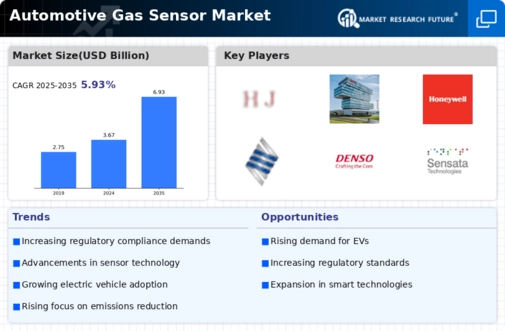Rising Demand for Connected Vehicles
The Automotive Gas Sensor Market is witnessing a notable shift towards connected vehicles, which are equipped with advanced communication technologies. This trend is driven by consumer preferences for enhanced safety, convenience, and real-time data access. Connected vehicles utilize gas sensors to monitor emissions and provide feedback to drivers, thereby promoting eco-friendly driving habits. Furthermore, the integration of gas sensors with vehicle-to-everything (V2X) communication systems allows for better management of emissions in real-time. As the automotive industry increasingly embraces connectivity, the demand for sophisticated gas sensors is expected to rise, thereby propelling the Automotive Gas Sensor Market forward.
Increase in Electric Vehicle Production
The increase in electric vehicle production is a significant driver for the Automotive Gas Sensor Market. As manufacturers pivot towards electric vehicles, the need for gas sensors remains relevant, particularly for monitoring air quality and ensuring compliance with environmental regulations. Electric vehicles, while producing zero tailpipe emissions, still require gas sensors to monitor cabin air quality and detect any potential leaks from battery systems. This dual functionality enhances the appeal of electric vehicles to environmentally conscious consumers. Consequently, the Automotive Gas Sensor Market is likely to benefit from the growing electric vehicle segment, as manufacturers seek to incorporate advanced gas sensors to meet both regulatory requirements and consumer expectations.
Regulatory Compliance and Safety Standards
The Automotive Gas Sensor Market is experiencing a surge in demand due to stringent regulatory compliance and safety standards imposed by various governments. These regulations aim to reduce harmful emissions and enhance vehicle safety, thereby driving the adoption of advanced gas sensors. For instance, the implementation of Euro 6 standards in Europe has necessitated the integration of high-performance gas sensors in vehicles to monitor emissions effectively. This regulatory landscape compels manufacturers to innovate and develop sensors that meet these requirements, thus propelling market growth. As a result, the Automotive Gas Sensor Market is likely to witness increased investments in research and development to create sensors that not only comply with existing regulations but also anticipate future standards.
Technological Advancements in Sensor Technology
Technological advancements play a pivotal role in shaping the Automotive Gas Sensor Market. Innovations such as miniaturization, enhanced sensitivity, and the integration of smart technologies are revolutionizing gas sensor capabilities. For example, the development of MEMS (Micro-Electro-Mechanical Systems) technology has led to the creation of compact and highly efficient gas sensors that can be easily integrated into various vehicle systems. This evolution in sensor technology not only improves the accuracy of gas detection but also reduces production costs, making it more accessible for manufacturers. Consequently, the Automotive Gas Sensor Market is poised for growth as these advanced sensors become standard in modern vehicles, catering to the increasing demand for efficient and reliable gas monitoring solutions.
Growing Awareness of Air Quality and Health Impacts
The growing awareness of air quality and its health impacts is significantly influencing the Automotive Gas Sensor Market. As urbanization increases, concerns regarding air pollution and its detrimental effects on public health have escalated. This awareness drives consumers and manufacturers alike to prioritize vehicles equipped with advanced gas sensors that can monitor and mitigate harmful emissions. According to recent studies, vehicles are a major source of urban air pollution, prompting regulatory bodies to enforce stricter emission standards. Consequently, the Automotive Gas Sensor Market is likely to expand as manufacturers respond to this demand by integrating sophisticated gas sensors into their vehicles, thereby contributing to improved air quality and public health.


















Leave a Comment